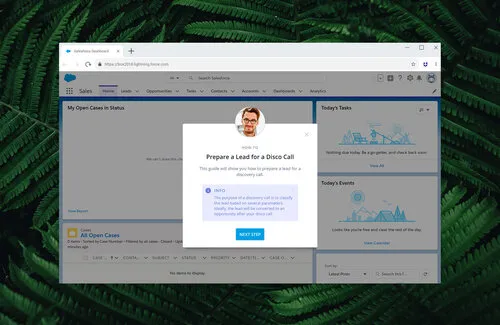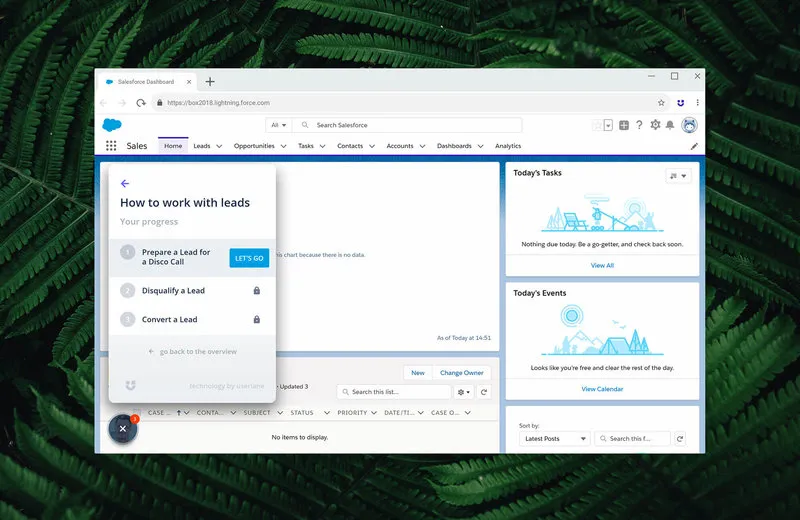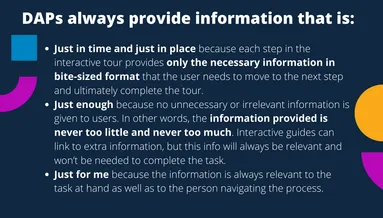Employee Performance Support With Digital Adoption Platforms

In our previous blog post, we delved into the importance of designing people-first products, especially in this day and age where we are constantly bombarded with notifications and overwhelmed by the millions of apps available to us (according to the 2019 Annual SaaS Trends Report from Blissfully, the typical mid-sized company saw almost 40% of their SaaS stack change in 2018, with the average company spending $343,000 on SaaS, which was a 78% increase from 2017).
Software is eating the world, make no mistake about it. The same report from Blissfully points out that as companies grow, “the average number of apps per company tends to increase on a linear basis.” This reveals that “rather than simply adding seats to apps that are already being used, companies are adding new apps as they grow in size.”
Adding to this, an independent survey, The False Promise of the App Economy, which questioned business professionals worldwide, revealed that the average number of apps used by the modern knowledge worker (back in 2017 when the survey took place) was 9.39. 43% of the respondents revealed that they have to switch between too many apps just to get basic work done, and 50% said that they looked at their email inbox at least five times per hour. So, the stone-cold truth is that app fatigue is just as real in the workplace as it is in our personal lives.
… [E]ven the best productivity tools can lead to a decrease in employee engagement, reduced productivity, information silos, and general confusion when knowledge workers are expected to balance too many different apps at the same time. — The False Promise of the App Economy
As the research from the survey shows, app fatigue, cognitive overload, and distractions are the main culprits preventing employees from being engaged and productive at work. And this is why designing human-centric products is so important. As we highlighted in our previous post, human products are better products, and if you’re a product designer in the SaaS industry, you must strive to create products that reduce cognitive overload and bring true value to the end-user.
Okay, but … we’re not going to write about designing people-first products again ????. This post is about your employees and the cognitive overload they experience from working with the average 9.39 apps daily to get their work done. While you may not have complete control over the number of apps your employees work with, you do have the upper hand when it comes to how you train your employees in new software, especially software that is extremely complex and seemingly overwhelming to learn.
So, cue the “4Js of learning” and digital adoption platforms! Let’s get to it …
Table of Contents
How Digital Adoption Platforms Leverage the 4Js of Learning and Performance Support
Here’s your scenario. You’ve just rolled out a new software application to your Sales and Marketing teams. It’s complex software, and the teams don’t exactly have time for long, in-person or online training sessions and wading through help document upon help document. These types of traditional training methods (PDF documents, handbooks, in-person training for hours on end) are a good example of cognitive overload because employees are bombarded with too much information that may or may not be relevant. Plus, they’re also likely to forget what they’ve learned in training once it’s over (it’s related to the Ebbinghaus forgetting curve).
So, then, how can you train your employees effectively? Well, a good starting point is to use the following 4Js* related to learning and performance support (we took this from Dr. Patrick Blum’s article, Lernen und Leisten im Kontext der digitalen Transformation):
- just in time,
- just in place,
- just enough, and
- just for me.
(* We decided to call it the 4Js of learning ????.)
The idea behind these 4Js is that when we learn something new (it doesn’t have to be software-related), the best way to learn it is by having just enough information at the very moment we need it to reach our learning goal. In a video on What is Just Enough, Just For Me, Just In Time? from Brand Learning, learning expert Martin Borret explains that optimal learning experiences are often bite-sized and accessible:
For an effective workplace learning program that is going to deliver performance improvements, we must focus on the learner’s needs, and in today’s world, that means the learning experience and resources need to be very much on the job. They need to be in the moment … and they need to be absolutely applicable to what the individual needs to do at that moment.
To break it down further, just enough means bite-sized information that is easily accessible (not too much, not too little), just for me refers to information that can be applied immediately to a task a person needs to perform, and just in time is having the right information at the very moment of need.
A better way to explain this is by looking at the example of digital adoption platforms (DAPs).
DAPs are designed to maximize software adoption, or, in other words, to get people working with new software as quickly and as efficiently as possible. DAPs can be used for employee training and support as well as customer onboarding and self-service.
As per our analogy, here’s how a DAP, like Userlane, leverages the 4Js of learning to train and support your Sales and Marketing Teams in the new software.

Interactive Guides (Just In Place, Just Enough)
The core technology of DAPs is interactive step-by-step guides, which lead users in real time through digital processes in a software application. These guides provide users with only the minimum required amount of information needed at a particular moment.
For our example, interactive tours (comprised of the guides) explain digital processes in the software application step-by-step, with each guide in the tour giving your employees just the right amount of information at just the right time and in the right place. This way, complex digital processes are broken down into steps (microlearning), and employees can achieve their in-app goals quickly without getting overwhelmed or distracted by irrelevant and unnecessary information.
So, with a DAP like Userlane, your employees only need to focus on the task at hand and work with little bits of information presented at just the right place and time to help them navigate the application with ease. No distractions. No unnecessary steps. And no cognitive overload.
Moreover, DAPs are also designed to keep users in-app at all times. This means that employees never have to leave the application or toggle between numerous tabs looking for help.
Virtual Assistant and Announcements (Just In Time)
DAPs also come with a Virtual Assistant (VA), which is available to provide on-demand, contextual performance support. This means that whenever an employee needs help with completing a particular task, they can simply click on the VA (no delay) to get just in time and just enough information to help them achieve their goal.
In addition to the VA, Userlane’s DAP also offers the Announcements feature, which can be used to provide further contextual help by linking to new interactive tours or tours the user has yet to complete. So, when your employees log into the application, they will immediately see the Announcement containing any new and important information.

Advanced Segmentation (Just For Me)
Another feature of DAPs is Advanced Segmentation. When it comes to software adoption, you need to provide your employees with relevance and personalization, and this is exactly what segmentation is for.
With Userlane’s DAP, you can show interactive guides only on specific pages to specific user segments. You can also take it further and show specific interactive guides to target users based on context, their engagement with the software, and their role. And when you create your target groups, you can provide even more contextual support by choosing from a list of specific rules to define unique user segments.
This all serves to provide personalized (just for me), just in time, just in place information to boost in-app engagement and productivity.
Promotions (Just In Time, Just In Place)
And last but definitely not least ????, the Promotions feature of Userlane’s DAP is designed to further motivate and engage employees. In any software application, there will always be certain processes or features that are more complex than others, and the Promotions feature is used to prompt users to start a specific interactive tour. In this case, your employees automatically receive contextual help without having to actively ask for assistance.
In Summary
DAPs are ideal for employee onboarding, training, and support because they leverage the 4Js of learning and performance support as shown below in the image:

Learning & Performance Support Must Be Human-Centric Too!
While this post focused heavily on digital adoption platforms and software training, the 4Js of learning can (and should!) be applied to any workplace learning and/or training.
Always keep in mind that what you do in your company should always put people (be they your employees or customers) first—and this absolutely goes for software training too. Chances are, your employees are all experiencing app fatigue and cognitive overload, so don’t add to this by using traditional training methods that are long-winded, overwhelming, and impersonal.
So, from now on, whenever you’re designing your next training course or learning material, remember your 4Js of learning and performance support, and you’ll be sure to boost employee engagement and motivation!
If you’d like more information on digital adoption platforms and how they can optimize your training and support experience, then book a demo with us!

